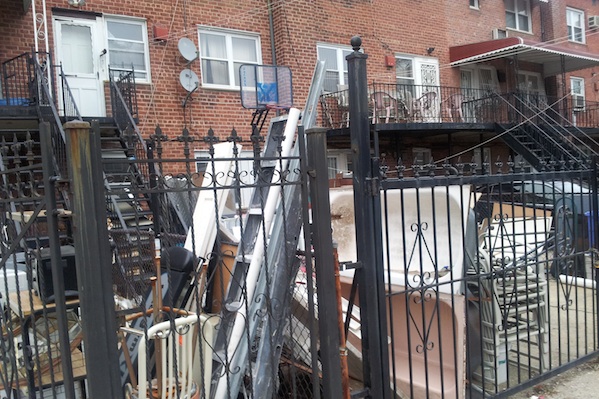
Photo by: Batya Ungar-Sargon
The neighborhood is also home to a large Haitian community. As in other Brooklyn neighborhoods, until Sandy, many immigrants lived in the basements of town houses owned by middle class residents.
One Brooklyn neighborhood has not gotten a lot of press since Hurricane Sandy made landfall seven weeks ago. In Brooklyn’s southeast corner, Canarsie is a mixed neighborhood of homeowners and renters. Located between Fresh Creek Basin and Jamaica Bay, thousands experienced flooding. Damage was sustained mostly to basements and first floors, with one to six feet of flooding.
Yet despite all this, Canarsie isn’t in Zone A. Also, it has been excluded from the city’s disaster food stamp service, or DSNAP.
“The city refuses to recognize what Canarsie has been through,” Assemblyman Alan Maisel, whose jurisdiction includes parts of Canarsie, says. “The DSNAP decision was completely arbitrary.” There are still over 10,000 individuals waiting on the list for Rapid Repairs, the city’s free program to restore heat, power, and electricity. 900 have already been serviced, and 1,200 are in the pipelines of recovery. “That’s 13,000 people,” Maisel says. “And they don’t even do mold remediation,” he adds.
Maisel complains as well of a lack of public information about mold and other risks. People don’t understand the dangers of the homes that have been affected by the flood. “One woman I went to has mold growing in her basement from the sheetrock,” Maisel says. “She says she can’t do anything about it. I said, close the door! But it was warped, so I told her to put up plastic until someone can come and fix it, I don’t care who, but get someone in here!”
But other elements factor in, aside from a lack of information. “The elderly are finding it hard to part with things,” Avrohom Hecht, director of the Jewish Community Council of Canarsie, says. “Basements are where you keep the clothing you wore at your wedding, and pictures. Mold is extremely toxic, but people can’t let go. The sanitation department has been wonderful. They just keep coming.”
Home-owners by and large seem to have been well served by FEMA. Many who were cleaning out their homes on December 20 reported having received sums large enough to cover a significant portion of the damage. But Maisel says that he has come across an unfair distribution of benefits to people in similar circumstances. “You’ll have two neighbors with the same basement flooding, the same damages, and one will get $6,000 and one will get $8,000.”
But the neighborhood is also home to a large Haitian community. As in other Brooklyn neighborhoods, until Sandy, many immigrants lived in the basements of town houses owned by middle class residents. “They’re the ones who really go screwed,” says Carlton Evans, a homeowner whose townhouse is on Paedergat St, which runs parallel to Paedergat Basin. Evans estimates the damage to his townhouse to be in the vicinity of $45,000, but between FEMA and his flood insurance, he has collected $30,000. “But my niece, she rented my basement, and she didn’t get anything, and she lost all her stuff.”
“There is an overlap between immigrants and basement dwellers,” Luckner Lerasseur, a FEMA specialist working out of the Holy Family Church, reports. “There is a large Haitian population in Canarsie. At first, some people were afraid to come to FEMA, but I’m Haitian, so I talk to them, make them feel comfortable.”
Lerasseur explains that FEMA has no responsibility to report persons without status who apply for aid, but Hecht of the JCC reports that still, “immigrants were fearful to apply.” That is, until he got a message from the mayor’s office that they needn’t worry. “They said, ‘We’re here to help them.’ The mayor’s office has been very helpful.”







